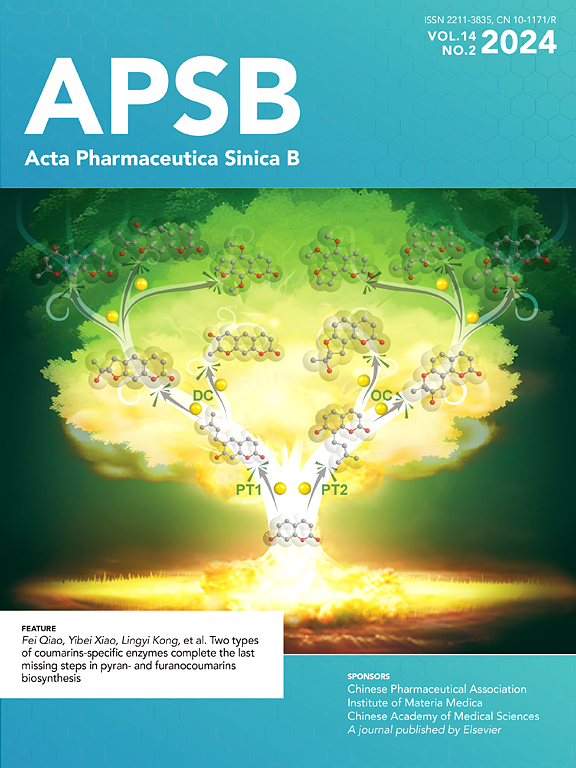磺胺甲醚A和B作为强效镇痛药:具有前所未有化学结构的多离子通道抑制剂
IF 14.7
1区 医学
Q1 PHARMACOLOGY & PHARMACY
引用次数: 0
摘要
副作用小、疗效高的多靶点镇痛药是解决全球疼痛危机的一个重要研究热点。采用分子网络方法,从除虫菊(a . pyrethrum)根中分离出5对强效镇痛生物碱对映体。通过综合光谱数据分析,包括LR-HSQMBC和1H-15N HMBC,量子13C NMR DP4+和ECD计算,以及单晶x射线衍射分析,阐明了它们的结构。蒽醌A(1)和B(2)是高度共轭和多甲基化的六环四氮杂基生物碱,具有前所未有的8,14,18,24-四氮杂-八氮杂基[16.8.2.11,23.04,28.05,17.09,16.011,15.021,27]壬烷基序。提出了它们的生物合成途径,包括关键醛醇、氢胺化和希夫碱反应。所有分离物在体内均表现出较强的镇痛作用。即使在0.2 mg/kg的较低剂量下,(±)-1和(+)-1仍表现出比吗啡更强的镇痛活性。有趣的是,外消旋混合物(±)-1在较高剂量(5和1 mg/kg)下比单独的纯对映体表现出更强的镇痛作用;而(±)-1在0.2和0.04 mg/kg较低剂量下表现出与(+)-1相当的显著镇痛活性。(+)-1的镇痛作用强于(−)-1。对44个镇痛相关靶点的实验表明,(+)-1对TRPM8、Kv1.2、Kv1.3、Cav2.1等多种离子通道均有明显的抑制作用,IC50分别为1.10±0.26、4.20±0.07、2.20±0.24、10.40±0.69 μmol/L;(−)-1对TRPC6、Kv1.2、Kv1.3离子通道的抑制作用分别为0.81±0.05、0.91±0.04、1.50±0.13 μmol/L,不影响阿片受体。提示它们的非阿片类镇痛潜力。分子对接为开发强效非阿片类镇痛药提供了结构指导。本文章由计算机程序翻译,如有差异,请以英文原文为准。

Anacyphrethines A and B as potent analgesics: Multiple ion channel inhibitors with an unprecedented chemical architecture
Multi-target analgesics with minimal side effects and high efficacy are a key research focus in addressing the global pain crisis. Using a molecular networking approach, five pairs of potent analgesic alkaloid enantiomers were isolated from the roots of Anacyclus pyrethrum (A. pyrethrum). Their structures were elucidated by comprehensive spectroscopic data analysis, including LR-HSQMBC and 1H–15N HMBC, quantum 13C NMR DP4+ and ECD calculations, and single-crystal X-ray diffraction analysis. Anacyphrethines A (1) and B (2) are highly conjugated and polymethylated 6/6/6/6/5/7/5/5-fused octacyclic tetraazabic alkaloids possessing an unprecedented 8,14,18,24-tetraaza-octacyclo[16.8.2.11,23.04,28.05,17.09,16.011,15.021,27] nonacosane motif. Their biosynthetic pathways are proposed involving key aldol, hydroamination, and Schiff base reactions. All isolates showed potent analgesic effects in vivo. Even at a lower dose of 0.2 mg/kg, (±)-1 and (+)-1 still exhibited more potent analgesic activities than morphine. Interestingly, the racemic mixture (±)-1 showed stronger analgesic effect than either pure enantiomer alone at higher doses of 5 and 1 mg/kg; while, (±)-1 showed significant analgesic activities comparable to (+)-1 at lower doses of 0.2 and 0.04 mg/kg. (+)-1 had stronger analgesic effect than (−)-1 at five tested does. Further tests on 44 analgesic-related targets demonstrated that (+)-1 showed significant inhibitory effects against many ion channels such as TRPM8, Kv1.2, Kv1.3, and Cav2.1 with IC50 values of 1.10 ± 0.26, 4.20 ± 0.07, 2.20 ± 0.24, and 10.40 ± 0.69 μmol/L, respectively, while (−)-1 primarily inhibited TRPC6, Kv1.2, and Kv1.3 ion channels with IC50 values of 0.81 ± 0.05, 0.91 ± 0.04, and 1.50 ± 0.13 μmol/L, respectively, without affecting the opioid receptors, suggesting their non-opioid analgesic potentials. The molecular dockings provided structural guidance to develop potent non-opioid analgesics.
求助全文
通过发布文献求助,成功后即可免费获取论文全文。
去求助
来源期刊

Acta Pharmaceutica Sinica. B
Pharmacology, Toxicology and Pharmaceutics-General Pharmacology, Toxicology and Pharmaceutics
CiteScore
22.40
自引率
5.50%
发文量
1051
审稿时长
19 weeks
期刊介绍:
The Journal of the Institute of Materia Medica, Chinese Academy of Medical Sciences, and the Chinese Pharmaceutical Association oversees the peer review process for Acta Pharmaceutica Sinica. B (APSB).
Published monthly in English, APSB is dedicated to disseminating significant original research articles, rapid communications, and high-quality reviews that highlight recent advances across various pharmaceutical sciences domains. These encompass pharmacology, pharmaceutics, medicinal chemistry, natural products, pharmacognosy, pharmaceutical analysis, and pharmacokinetics.
A part of the Acta Pharmaceutica Sinica series, established in 1953 and indexed in prominent databases like Chemical Abstracts, Index Medicus, SciFinder Scholar, Biological Abstracts, International Pharmaceutical Abstracts, Cambridge Scientific Abstracts, and Current Bibliography on Science and Technology, APSB is sponsored by the Institute of Materia Medica, Chinese Academy of Medical Sciences, and the Chinese Pharmaceutical Association. Its production and hosting are facilitated by Elsevier B.V. This collaborative effort ensures APSB's commitment to delivering valuable contributions to the pharmaceutical sciences community.
 求助内容:
求助内容: 应助结果提醒方式:
应助结果提醒方式:


